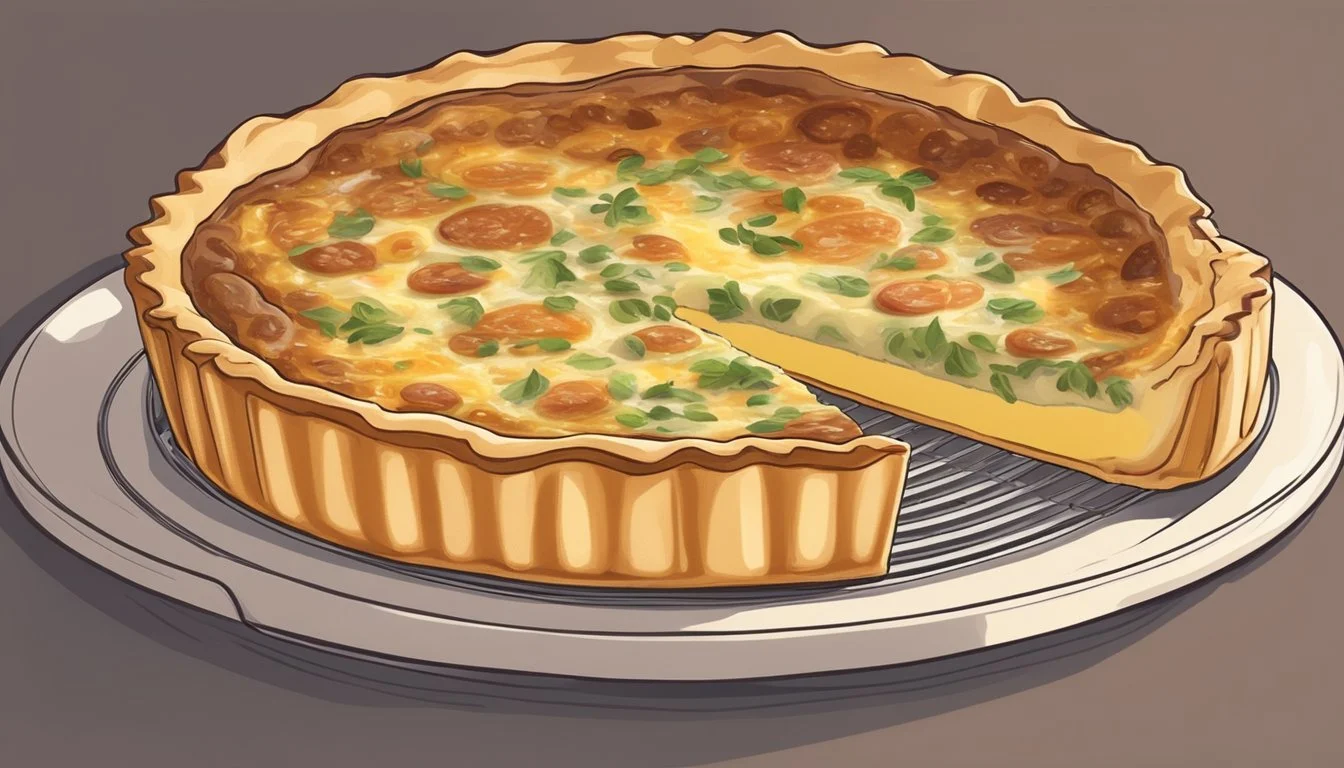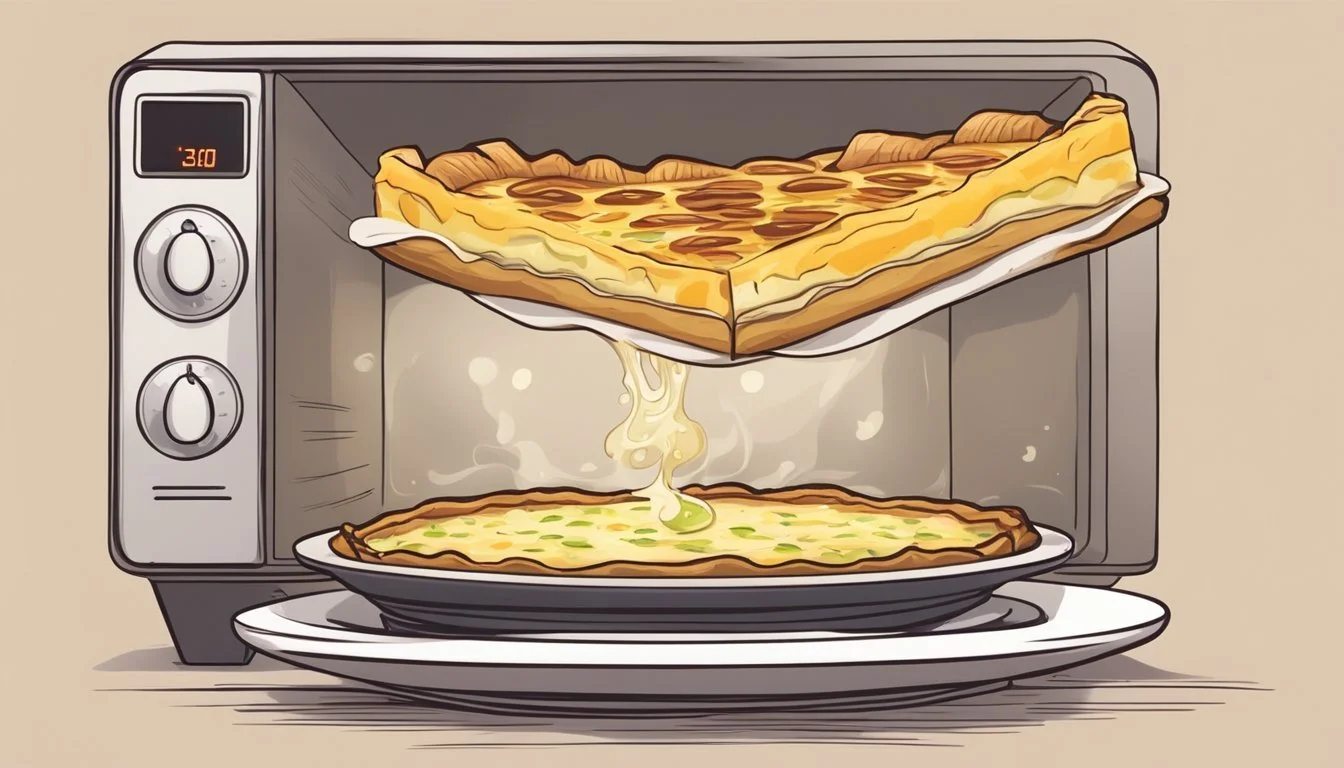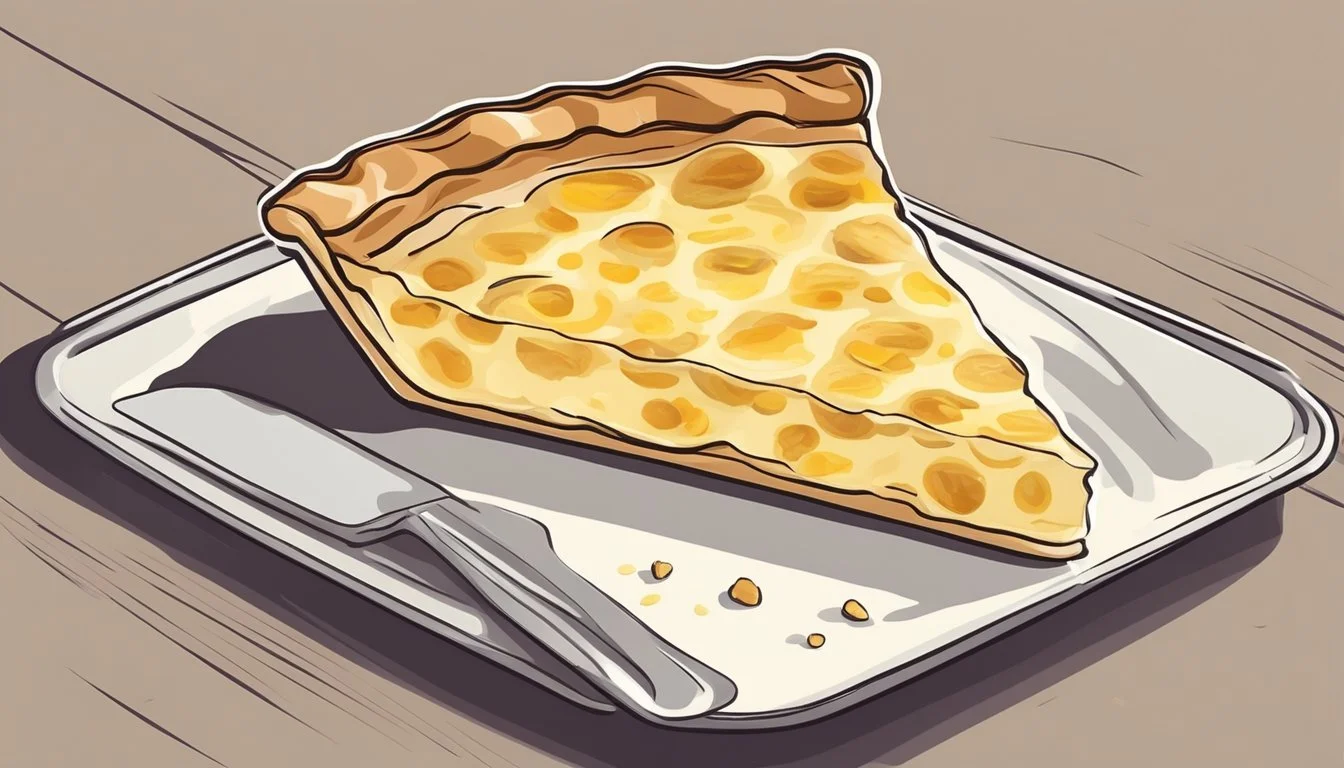Best Way to Reheat a Slice of Quiche Lorraine
Ensuring a Crispy Crust Every Time
Reheating a slice of Quiche Lorraine presents a unique challenge; the goal is to warm the filling without compromising the flaky, buttery quality of the crust. Given that Quiche Lorraine is a delicate balance of rich custard and crisp pastry, the reheating method plays a crucial role in maintaining the integrity of this classic dish. Ensuring the crust remains flaky and the filling reaches a safe temperature requires a careful approach that considers the diverse textures.
The best way to reheat Quiche Lorraine involves gently warming it in the oven, a method that evenly distributes heat and preserves the crust's flakiness. It's advised to bring the slice to room temperature before reheating to avoid thermal shock which can lead to a soggy crust. Covering the crust with foil can prevent it from browning too much, while the rest of the slice heats through. It's essential to monitor the quiche's internal temperature for both safety and quality, aiming for the filling to reach 165 degrees Fahrenheit. This method affords control over the reheating process, safeguarding the delectable contrast between the creamy filling and its flaky encasement.
Understanding Quiche Lorraine
Quiche Lorraine is a classic French tart that combines a creamy egg custard base with savory components encased in a flaky pastry. Proper handling post-cooking and storage directly influence its flavor and texture upon reheating.
Composition and Characteristics
Quiche Lorraine consists of eggs, cream, cheese, and bacon, all nestled within a pastry crust. The quintessential characteristics of a well-made Quiche Lorraine are its fluffy custard filling and crispy crust.
Post-Cooking Challenges
Once cooked, this delicious food, like many egg-based dishes, is prone to several issues if not handled correctly: the crust can become soggy, and the custard may turn rubbery or risk drying out upon reheating.
Storage Fundamentals
To store Quiche Lorraine:
Let it cool to room temperature before storage.
Wrap with plastic wrap or in an airtight container.
Refrigerate for a few days or freeze for extended storage.
Reheating Quiche Benefits
Proper reheating can restore Quiche Lorraine to its just-baked glory, ensuring the crust remains flaky and the filling fluffy and warm.
Potential Reheating Pitfalls
Incorrect reheating techniques may cause the Quiche Lorraine to become soggy, rubbery, or dried out. The key is gentle and even heating to maintain the crust's crispiness.
Proper Reheating Techniques
When reheating a slice of Quiche Lorraine, it is crucial to preserve the flakiness of the crust while ensuring the filling is thoroughly heated. Various appliances can be employed, each requiring different steps to achieve the best results.
Oven Reheating Method
Using an oven is the most effective way to reheat Quiche Lorraine while keeping the crust flaky. Preheat the oven to 350 degrees Fahrenheit. Place the quiche slice on a baking sheet and cover the crust edges with aluminum foil to prevent over-browning. Heat for about 20-25 minutes, checking that the internal temperature reaches 165 degrees Fahrenheit.
Microwave Reheating Steps
If you're short on time, a microwave can reheat a slice quickly, though it might not keep the crust as crisp. Put the quiche on a microwave-safe plate and heat on medium power for 1-2 minutes. It's important to avoid overheating, as it can make the crust soggy.
Toaster Oven Approach
A toaster oven offers a more compact solution and can provide an even distribution of heat similar to a full-sized oven. Preheat the toaster oven to 350 degrees Fahrenheit, place the quiche on the rack, and cover it loosely with foil. Reheat the slice for 10-15 minutes, until it's evenly warmed through.
Air Fryer Reheating Strategy
An air fryer can reheat a slice of Quiche Lorraine efficiently. Set the air fryer to 350 degrees Fahrenheit and place the quiche in the basket, ensuring some space is left around the slice for air circulation. Heat for 3-4 minutes, and check that it’s heated to the right internal temperature.
Thawing Frozen Quiche
When handling frozen quiche, either a gradual thaw in the refrigerator or direct reheating maintains the quality. Each approach suits different schedules and desired outcomes for the final texture.
Safe Thawing Procedures
Thawing frozen quiche in the refrigerator is the preferred method for ensuring safety and quality. It's a simple process:
Place the frozen quiche in the refrigerator.
Allow it to thaw slowly, typically overnight or for 24 hours.
This gradual thaw helps maintain the flakiness of the crust and homogeneity of the custard filling.
Direct Reheating from Frozen
For those short on time, reheating frozen quiche directly is also an option:
Oven: Preheat to 350 degrees Fahrenheit, place the frozen quiche on a baking sheet, and cover with foil. Reheat for 30 to 45 minutes or until the internal temperature reaches 165 degrees Fahrenheit.
Microwave: If urgency is key, use the microwave on a microwave-safe plate, heat the quiche for 3 minutes, let it sit for a minute, and continue in 30-second bursts if necessary.
Direct reheating requires vigilance to prevent a soggy crust or unevenly heated filling.
Serving Reheated Quiche
Reheating quiche Lorraine properly is pivotal to preserving the flaky crust and ensuring the cheese remains melted and delightful. Precise attention to how the quiche is served can elevate a simple meal to feel like a brunch (What wine goes well with brunch?) at a sophisticated café.
Ensuring Optimal Taste and Texture
Once the slice of quiche Lorraine is adequately reheated, it is crucial to allow it to rest for a short period before serving. This resting period lets the heat distribute evenly, stabilizing the internal temperature and preventing the crust from becoming soggy. A quiche should have a flaky crust and a warm, creamy center that highlights ingredients like bacon, ham, spinach, or mushroom.
Rest Time: Allow the quiche to rest for approximately 3-5 minutes after reheating.
Temperature Check: Ensure the quiche reaches an internal temperature of 165 degrees Fahrenheit, indicating it is heated thoroughly and safe to consume.
Presentation and Accompaniments
Presentation matters when serving quiche Lorraine, be it for a solo meal or at a brunch gathering. It should be accompanied by sides that complement its rich flavors without overpowering them. Aesthetically, quiche is best served on warm plates to maintain temperature consistency.
Plates: Preheat plates in the oven at a low temperature (around 150 degrees Fahrenheit) before dishing the quiche.
Sides: Offer a fresh salad with a light vinaigrette or sautéed vegetables to balance the richness. Consider adding a spoonful of light crème fraîche or a dollop of soft goat cheese on the side for added decadence.
Herbs and Spices: Garnish with a sprinkle of fresh herbs like parsley or chives (how long do chives last?) to enhance the visual appeal and flavor.
Reheating Quiche FAQs
When considering reheating slices of Quiche Lorraine, one may face concerns about maintaining the flakiness of the crust, heating slices evenly, and pinpointing the correct cooking times and temperatures. The following FAQs address these issues to ensure a satisfying reheated quiche.
Common Concerns and Solutions
Can You Freeze Quiche? Absolutely. One can freeze quiche and reheat it directly from the freezer. When ready to serve, preheat the oven to 350°F and bake until the internal temperature reaches 165°F.
How to Store Quiche: Cool the quiche, then cover it with cling film or aluminum foil, or place it in an airtight container. Refrigerated quiche will last for 3-4 days.
Reheating Tip: To keep the crust from getting soggy, use a knife to separate the quiche's crust from the dish slightly before heating.
Heating Multiple Slices Simultaneously
If reheating multiple slices, arrange them on a baking sheet without touching to ensure even heat distribution. Cover with foil and bake in a preheated 350°F oven for approximately 15-25 minutes.
Temperature Consistency: Use an oven thermometer to confirm the actual temperature of your oven to avoid overheating.
Power Consideration: If using a microwave, reheat at a low-to-medium power setting and check the quiche's warmth every 30 seconds.
Adjusting Cooking Times and Temperatures
For a Single Quiche Slice:
Oven: Preheat to 350°F, heat for 10-15 minutes.
Microwave: Use a low-to-medium setting, start with 2 minutes, check, and add 15-20 second bursts as needed.
For a Whole Quiche:
Oven: Preheat to 350°F, cover with foil, and heat for 20-25 minutes.
Microwave: Not recommended for whole quiches due to uneven heating.
Remember to allow for a rest time after reheating—this helps to redistribute the heat throughout the quiche slices before serving.
Conclusion
When reheating a slice of Quiche Lorraine, maintaining the flakiness of the crust is a priority. Leftover quiche can be as delightful as when freshly baked if reheated properly. It’s important to preheat the oven to 350°F (175°C) before placing the quiche inside. This ensures a gentle and even reheating process. Covering the slice with aluminum foil protects the crust from excessive browning and keeps the filling moist.
Here are several key reheating tips to follow:
Door of Patience: Wait until the oven reaches the set temperature before inserting the quiche.
Shield of Foil: Cover the slice loosely with foil to safeguard the pastry.
Timekeeper: Heat for 10-15 minutes. Quiche Lorraine’s crust remains flaky when not overexposed to heat.
Final Check: Confirm internal temperature reaches 165°F (74°C) for safety.
One can appreciate the versatility of Quiche Lorraine in its ability to be enjoyed beyond the initial serving. It can be part of various meal settings, from breakfast to dinner, without losing its original charm.
A homemade quiche carries a certain magic that is preserved with these reheating steps. Its careful preparation and balance of flavors deserve to be experienced even on the second day. By adhering to these guidelines, the quiche will provide a satisfying meal with a crust that speaks of attention and care.






